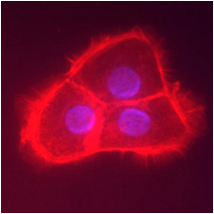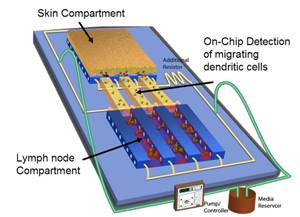Elastin like peptide (ELP) Based Drug Delivery Systems
We are interested in the application of a novel class of polymers Elastin like Peptides (ELPs) as drug delivery vehicles. The use of ELPs as drug delivery vehicles is attractive because of their unique phase transitioning property. ELPs are soluble in aqueous solution but as the temperature is raised above their transition temperature they self assemble and precipitate out of the solution. Due to this property, ELPs can be expressed in bacterial hosts and purified rapidly through a series of hot and cold spins. In addition because of this unique property of ELPs, they self assemble into nanoparticles of different sizes that can fine tuned by choosing different ELP sequences. We are interested in using ELPs as drug delivery vehicles by generating a fusion protein of the bioactive compound of interest and ELPs. We and several others have shown that the performance characteristics of ELPs and the bioactive compound are maintained after the fusion. We are investigating the use of these Chimeric ELP nanoparticles as drug delivery vehicles for enhancing tissue regeneration and targetted chemotherapy for cancer treatments.
 |
Molecular Mechanisms involved in Cell Adhesion & Migration
Cellular adhesion and migration are important processes and find application in tissue engineering and cancer metastases. Our major interest is to elucidate molecular mecahnisms that yield to loss in cell adhesion and hence migration when they are exposed to an external stimuli. For example, how the break in cell adhesion during injury transforms into a migratory response of skin cells that lead to wound coverage. Specifically, we are interested in the role of MAPK pathways (ERK and JNK), C/EBP transcription factors and adhesion proteins (E-cadherin, a-catenin and b-catenin) in cell adhesion and migration.
In context of wound healing, we are interested in two primary players involved in wound repair are fibroblasts and keratinocytes. Fibroblasts are important as they proliferate and lay down the matrix (Granulation) on which the keratinocytes migrate on in order to fill the defect (Re-epithelialization). There is a fine balance between granulation and re-epithelialization in order to achieve optimum wound repair. Our lab is interested in understanding and identifying the crucial players in granulation and re-epithelialization and how this balance is achieved. Finally, we are interested in how cells interact with the extracellular matrix (ECM), process information and then exhibit a response.
 |
Dynamic Living Systems as models of Cellular Processes & Diseases
In order to interrogate molecular mechanisms simple yet realistic in vitro models of complex biological processes are required. For most studies of cellular behavior, simple two dimensional cell culture systems might be sufficient. However, recently it is becoming clearer that not only the cell type under study is important but also the microenvironment in which the cell is cultured determines its behavior. Moreover, the tissue architecture and the position at which the cell is present in the tissue is an equally important factor in cell behavior. For example, the epidermis is a multilayered tissue where every layer is different than the previous layer and has different functions. The complexity is lost in two dimensional cell culture systems. Some complex biological processes e.g skin inflammation and cancer metastasis require interaction of two spatially separated tissues at the nano/microscale. In order to model these complex processes we are developing novel in vitro models using Tissue engineering & Microfabrication.